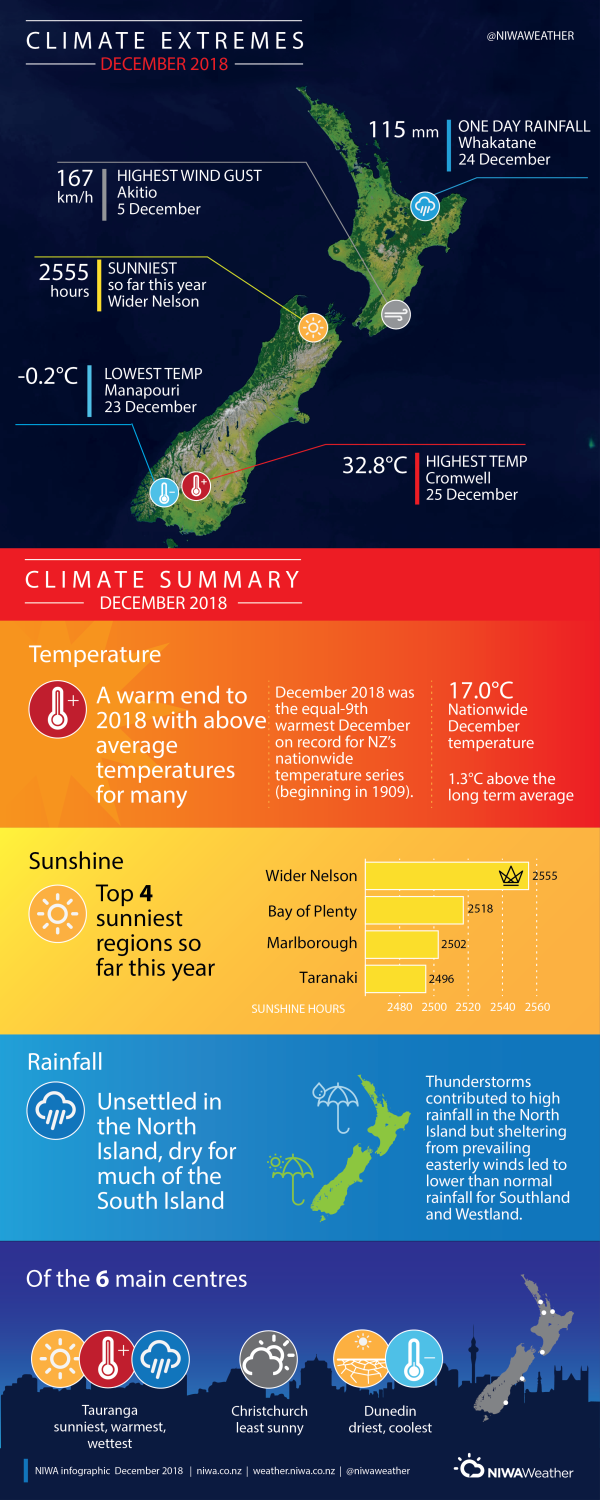Wet end to the year for the North Island and north-eastern South Island
|
Rainfall |
Rainfall was well above normal (>149% of normal) for the majority of the North Island with the exception of Taranaki and parts of Northland and Manawatu-Whanganui where rainfall was near normal (80-119% of normal). Rainfall was also well above normal for Marlborough and northern Canterbury while the remainder of the South Island saw largely below normal (50-79% of normal) rainfall. |
|
Temperature |
Temperatures were well above average (> 1.20°C above average) for the regions of Southland, the West Coast, Nelson, as well as large parts of Otago, Tasman, Manawatu-Whanganui, Waikato and the Bay of Plenty. Temperatures were near average (-0.50°C to +0.50°C of average) along the coastal fringes of eastern Marlborough and Canterbury as well as for Gisborne through to Masterton. Elsewhere temperatures were above average (0.51-1.20°C above average). |
|
Soil Moisture |
As of 1 January, soils were significantly wetter than normal for the time of year across large parts of the eastern and inland South Island, as well as large parts of the North Island. Soil moisture levels were lower than normal for the time of year in Nelson, Tasman, Southland, the New Plymouth district and parts of the West Coast. |
Overview
December 2018 was characterised by slightly lower than normal pressure over the North Island and higher than normal pressure over the South Island. This pressure set up was associated with more easterly winds than normal.
The prevalence of warm and moist easterly to north-easterly winds contributed to an unsettled month for much of the North Island and northeast of the South Island, with frequent periods of atmospheric instability contributing to many days of thunderstorm activity (see Highlights and extreme events for further details). Conversely, southern and eastern parts of the South Island experienced many dry and sunny days throughout the month resulting in below to well below normal rainfall totals.
The frequent origin of tropical airmasses led to widespread warm temperatures. Overall, the nationwide average temperature in December 2018 was 17.0°C (1.3°C above the 1981-2010 December average from NIWA’s seven station temperature series which begins in 1909). This ranked as the 9th equal warmest December on record.
Further highlights
- The highest temperature was 32.8°C, observed at Cromwell on 25 December.
- The lowest temperature was -0.2°C, observed at Manapouri on 23 December.
- The highest 1-day rainfall was 115 mm, recorded at Whakatane on 24 December.
- The highest wind gust was 167 km/h, observed at Akitio on 5 December.
- Of the six main centres in December 2018, Tauranga was the warmest, sunniest and wettest, Christchurch was the least sunny, Dunedin was the coldest and driest.
- Of the available, regularly reporting sunshine observation sites, the sunniest four locations in 2018 are Wider Nelson (2555 hours), Bay of Plenty (2518 hours), Marlborough (2502 hours) and Taranaki (2496 hours).
- Of the available, regularly reporting low elevation rainfall sites, the two wettest locations in 2018 are Milford Sound (5945 mm) and Arthur’s Pass (4698 mm). The two driest locations in 2018 are Clyde (526 mm) and Cromwell (541 mm).
Download
December 2018 climate summary information [PDF 3MB]
December 2018 climate statistics [PDF 75KB]
Contact
Nava Fedaeff, Climate Scientist Tel. 09 375 6337

